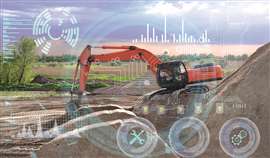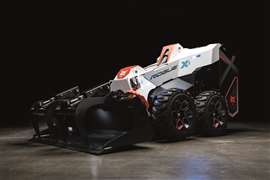Read this article in Français Deutsch Italiano Português Español
Automation and machine control: A marathon, not a sprint
26 June 2024
As the construction industry moves towards greater technological advancements, Catrin Jones explores whether machine control can help alleviate some of the challenges it faces.
 A reluctance to adopt technology is preventing some companies from reaping the benefits of automation (Photo: AdobeStock)
A reluctance to adopt technology is preventing some companies from reaping the benefits of automation (Photo: AdobeStock)
Contractors are facing increasing pressure to complete projects within shrinking budgets and timelines.
Combine that with the need for sustainable practices, a shortage of skilled labour and the rising costs of fuel and materials and it’s a challenging situation.
But one technological advance that has the potential to help tackle these problems is machine control. By accurately positioning machinery on construction sites and automating their movements based on approved design layouts, machine control can help teams complete projects faster and more accurately – and with lower fuel consumption, and fewer skilled personnel.
Contractors are no strangers to machine control. All but 3% of respondents claiming to use automation in some capacity in a survey conducted by global positioning company Topcon last year.
Despite this, Topcon’s report states that 46% are using it on less than a quarter of their projects, according to its research, which examines the future of machine control.
That suggests that for many, their experience with machine control is still in its infancy or confined to limited types of projects or applications.
The report, which involved a survey of companies across Europe, suggests that Germany (36%) and Scandinavia (36%) are the biggest adopters of automation. This is closely followed by the UK at 32% and Belgium at 31%.
On average, that meant that only 34% of European projects are taking advantage of the benefits automation can offer.
Time and investment
John Downey, senior director of sales at Topcon Positioning Systems, says, “Investigation into the barriers to adoption reveals a working environment where machine control struggles to compete against a range of other, arguably more immediate, concerns for the time and investment needed to implement the technology on more projects.
 Bobcat’s Rogue X2 skid steer loader (Photo: Bobcat)
Bobcat’s Rogue X2 skid steer loader (Photo: Bobcat)
“It is in this context that the need for more government support and regulatory pressure is imperative, which will add urgency and incentive to embrace digital construction methods.”
It is clear that these barriers to adoption are preventing some companies from reaping the benefits of automation, but what is the real potential for automation and how can it change traditional construction processes?
Cameron Clark, business area director for earthmoving at Trimble, says that automation is transforming traditional construction processes in two key ways – by making it easier to get the job done faster, with greater accuracy and fewer people, and by making it easier to gather and share jobsite data for better decision-making.
Clark says, “Task automation is helping contractors of all sizes offset the challenges of the labour shortage because it allows them to do the same work with fewer or less-experienced people.
“In some cases, automating tasks on the job site means you can now do with one person what used to take two – which is instrumental in keeping jobs moving when there just aren’t enough people to do the work.”
Automation is also making these jobs more appealing for workers, which helps offset hiring challenges adds Clark.
“Horizontal steering control makes the job of operating a soil compactor much easier and more enjoyable, for example, which makes it easier to find people who are interested in doing it and helps improve job satisfaction among operators.”
Trimble says that it is about more than just automating one machine or one task, but about connecting machines, people and the field to the office.
“This is transforming job sites in a lot of compelling ways, including reducing trips between the office and field, making it easier to share and make decisions from real-time job site data, and eliminating wasted time, materials and money,” the company says.
Time for a full transition
Ferhan Ficici, engineering manager for backhoe loaders and wheeled loaders at Hidromek, agrees with Clark that the trend toward automation does have an impact on the traditional construction process. He believes, however, that the industry is making positive moves towards a full transition.
During the last couple of years, the operational process has changed in all sectors, and it is still changing. Despite this change, safety is still paramount and something that many companies are seeking to improve.
Ficici says, “With advancements in sensors, actuators, embedded software, AI and cloud computing, operator assist systems are being developed. This makes working fields and machines safer. Added to this, the developments in radar and camera technologies are providing a great contribution to occupational safety.”
Naturally, this transition has affected the construction machinery industry. Ficici continues, “Construction machines have a very wide working field range, including difficult or dangerous sites such as tunnel constructions or sites where blasting occurs.
“Heavy machinery operators are often exposed to harsh and dangerous environments around the job site. Remote controlling solves such troubles and creates an optimal work environment for operators.”
Hidromek says it is running studies on how best to contribute to digitalisation and the company launched Hidromek Opera as a result of this research.
Opera enables the operator to control the requested machines from the office or any other place without going to the job site. The company recently exhibited Hidromek Opera at the Smopyc trade fair in Spain, from where it remotely operated an HMK 635 WL wheeled loader located in Ankara, Turkey.
What is the future of machine control?
 The Trimble Earthworks Grade Control platform for autonomous compactors was installed on a Dynapac CA 5000 soil compactor (Photo: Trimble/Dynapac)
The Trimble Earthworks Grade Control platform for autonomous compactors was installed on a Dynapac CA 5000 soil compactor (Photo: Trimble/Dynapac)
Trimble’s Clark anticipates that automation will continue its slow but steady march forward over the next decade and into the future, with a focus on automating new tasks on new machine types.
“We are actively testing a fully autonomous soil compactor on live job sites and would expect to see more of this kind of testing and innovation in coming years, as well,” he says.
During Trimble’s Dimensions conference in Las Vegas, US, last year, the industry heard about how the company has completed its first test of a fully autonomous soil compactor on a live job site, marking a significant step on its path to having autonomous vehicles operating on construction sites.
The Trimble Earthworks Grade Control platform for autonomous compactors was installed on a Dynapac CA 5000 soil compactor and was tested on the Site C Clean Energy Project at the Peace River in northeast British Columbia in Canada.
“We like to remind our customers that the industry’s innovation around and adoption of construction automation is a marathon, not a sprint,” highlights Clark.
“But there are real solutions on the market right now that are delivering big benefits on job sites in terms of being able to do more work, with increased accuracy and safety. Another big benefit of the technology available today is the ability to get less experienced workers up to speed faster, so you can get the same work done with fewer – or newer – people.”
Artificial intelligence (AI) is already revolutionising the construction industry and we are not far away from this flowing into our machines, says Vijayshekhar Nerva, head of innovation and acceleration for Europe, Middle-East and Africa at Bobcat.
“AI and machine learning are already enabling predictive maintenance to minimise downtime in many cases however I see a future where such technology could allow for complex autonomous operations, enhance awareness through AI-powered hazard detection, and optimise design and planning processes,” Nerva comments.
“This transformation could bring significant benefits like increased productivity, improved awareness, cost savings, and higher quality construction work.”
However, Nerva cautions, challenges such as the upfront costs of implementation, the need for workforce upskilling, cybersecurity risks and gaining trust in autonomous systems will need to be addressed.
Despite the current challenges it is highly likely that the future of the industry will be shaped, in no small part, by this technology.
STAY CONNECTED


Receive the information you need when you need it through our world-leading magazines, newsletters and daily briefings.
CONNECT WITH THE TEAM











